Urea Fertilizer for Apple Trees, as it provides the necessary nitrogen and nutrients for proper growth and fruiting. Proper fertilization during the active growth and fruit-bearing stages is crucial for apple trees. Neglecting this aspect can significantly reduce orchard productivity and result in poor yields. Unfortunately, many orchard owners still lack a proper fertilization plan for apple, pear, and quince trees. Urea fertilizer is a key component for enhancing fruit production and strengthening apple trees, ensuring a healthy and productive orchard.
Efficient use of urea fertilizer to enhance tree performance is considered one of the key objectives in agriculture. Proper timing of urea application ensures maximum nutrient absorption by plants. Plants typically absorb water and nutrients through their roots, which is why fertilizers are applied to the soil. In this article, we examine the timing of urea fertilizer application for apple trees and its effects on improving tree productivity.
What is Urea Fertilizer, and Why Is It Essential for Apple Trees?
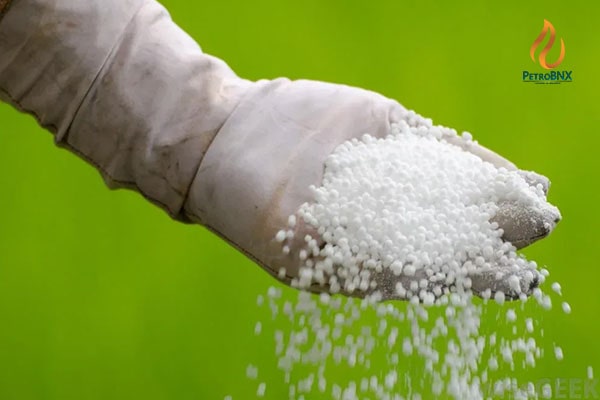
Urea fertilizer is one of the most commonly used nitrogen fertilizers in agriculture, composed of nitrogen, carbon, and hydrogen. Its chemical formula is (NH4)2CO3, making it a rich source of nitrogen, carbon, and hydrogen for plants. This fertilizer is available in the market as white granules or crystalline grains and is used to provide nitrogen needed by plants during different growth stages, particularly fruit trees like apples.
Factors Making Urea Fertilizer Essential for Apple Trees:
- Providing required nitrogen for growth
- Enhancing fruit quality
- Strengthening the root system
- Increasing resistance to diseases and environmental stresses
- Improving tree appearance and structure
Best Season for Applying Urea Fertilizer in Apple Orchards
At the beginning of spring, trees enter an active growth phase, ready for new development. Spring is the best season for fertilizing apple trees, as they wake up from winter dormancy and require nitrogen for new leaf and branch growth.
Best Time to Use Urea Fertilizer for Apple Trees
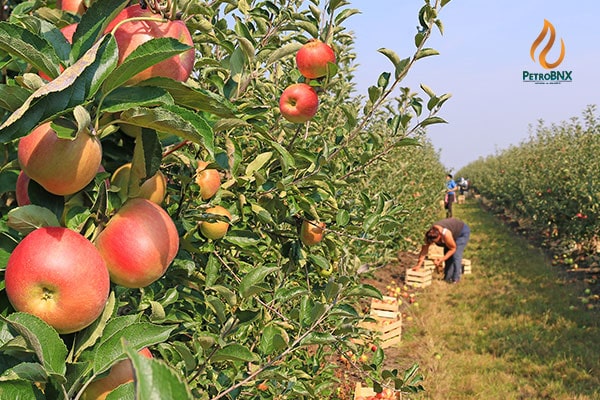
The ideal time for urea application depends on the tree’s growth phase and its nutritional needs in each season. As mentioned earlier, early spring is the best time for urea application, as the trees have passed the cold season and are preparing for active growth.
- Early Summer (During Active Growth): During the growing season, apple trees need nitrogen for new leaf production and overall growth. Applying urea fertilizer in early summer promotes optimal growth and enhances photosynthesis. However, excessive nitrogen application at this time can overly stimulate leaf growth and reduce fruit quality.
- Autumn (Post-Harvest): After fruit harvest, during the tree’s resting phase, urea acts as a booster to prepare the trees for the next year. Fertilizing in autumn is a preventive measure to strengthen trees for robust growth in the coming year, improving their condition and resistance to winter while ensuring a strong start in spring.
Effect of Urea Fertilizer on Apple Tree Growth and Yield
Urea fertilizer, as a rich nitrogen source, is one of the most significant factors influencing apple tree growth and yield. Nitrogen not only supports plant growth but also plays a critical role in processes like photosynthesis, protein production, and branch and leaf development, enabling the rapid production of new leaves and branches. This fertilizer also helps roots absorb water and nutrients more effectively from the soil. Without sufficient nitrogen, apple trees exhibit weak growth, with early yellowing of leaves. Urea application aids in rapid cell regeneration and alleviates nitrogen deficiency symptoms.
Urea fertilizer can directly increase fruit quantity, improve quality, enhance fruit weight, and regulate balanced fruiting. Controlled use of urea prevents excessive fruiting, ensuring high-quality produce. Trees that receive balanced fertilization can yield quality crops every season.
Urea Fertilizer Application Schedule for Apple Trees
| Fertilization Goal | Application Time | Tree Growth Stage |
|---|---|---|
| Early branch and leaf growth | Early spring | Before blooming |
| Feeding growing fruits | Mid-spring | After flower shedding |
| Enhancing fruit size and quality | Early summer | During active fruit growth |
| Nutrient storage for the next year | Autumn (pre-freeze) | After fruit harvest |
Is Urea Fertilizer Useful for Apples in Autumn?
Using urea fertilizer in autumn, a critical period for apples, can be beneficial but must be done cautiously and at the right time. During this period, post-harvest, trees enter a resting phase, but underground activities like root growth and nutrient storage for the next growing season continue.
Correct Method of Urea Fertilization for Apple Trees in Spring
- Step One: Spread urea fertilizer under the tree canopy (the area shaded by branches), as this is where nutrient-absorbing roots are concentrated.
- Step Two: Mix the fertilizer with the soil to reduce contact with the surface, preventing nitrogen loss as ammonia.
- Step Three: Irrigate immediately after application to help the fertilizer penetrate the soil and reach the roots. Proper irrigation enhances nitrogen absorption and prevents root burn.
The amount of urea fertilizer depends on tree age, soil conditions, and the tree’s nutritional needs:
- Young trees (1-3 years): Approximately 100-200 grams per tree.
- Mature trees (4+ years): 300-500 grams per tree, depending on yield and soil condition.
Common Mistakes in Urea Fertilizer Application for Apple Trees
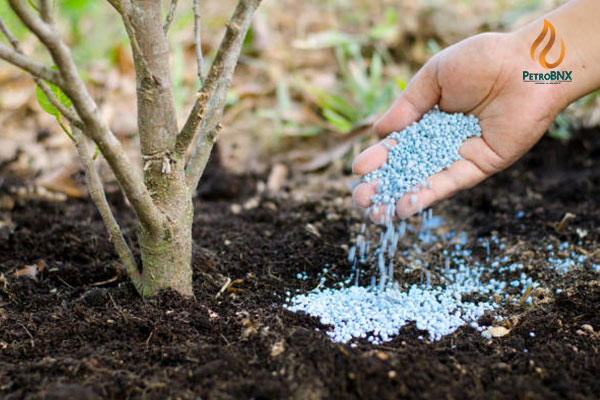
- Divide the total fertilizer into two or three doses during spring to ensure gradual nitrogen absorption and minimize loss.
- Avoid over-fertilizing, as it stimulates excessive branch and leaf growth while reducing tree yield.
- Fertilize during moderate weather conditions, as heavy rainfall can wash away the fertilizer, preventing plant absorption.
Side Effects of Incorrect Urea Application
Improper urea use can negatively affect tree growth, health, and yield due to overuse, poor timing, or incorrect methods:
- Root and Leaf Burn: Excessive urea or direct contact with roots/leaves causes nitrogen buildup, leading to root toxicity, leaf yellowing, or drying.
- Excessive Vegetative Growth: Overuse of nitrogen results in abnormal branch and leaf growth, reducing fruit quality and yield.
- Reduced Cold Resistance: Late-season application can trigger untimely growth, leaving branches and buds vulnerable to winter damage.
- Environmental Pollution: Excessive urea or fertilization before heavy rain can cause nitrogen runoff, harming ecosystems.
- Soil Nutrient Imbalance: Overuse of urea without supplying other nutrients like potassium and phosphorus disrupts balanced growth, weakening branches and making trees prone to pests and diseases.
Why Choose PetroBNX for Urea Fertilizer for Apple Trees?
At PetroBNX, we provide high-quality urea fertilizer specifically formulated to meet the needs of apple trees. Our urea fertilizer helps boost nitrogen levels, ensuring optimal growth, better fruiting, and healthier trees. With years of experience in the industry and a commitment to excellence, we guarantee competitive prices and reliable delivery. Whether you’re managing a small orchard or a large-scale farm, PetroBNX is your trusted partner for all your fertilizer needs. Contact us today to learn more about our products and how we can support your apple tree growth!
Conclusion
In general, urea application for apple trees must be balanced, as excessive use can seriously damage trees. Proper timing and dosage ensure effective results.
FAQs
When is the best time to use urea fertilizer?
Early spring and mid-growth stages are ideal for strengthening trees.
How should urea be applied to apple trees?
Evenly spread the fertilizer around the tree canopy, mix it with soil, and irrigate to enhance absorption.


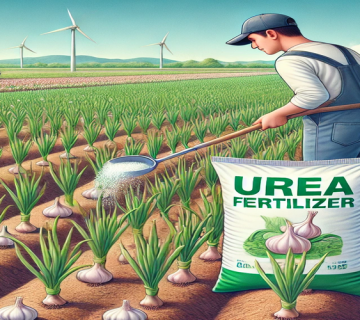
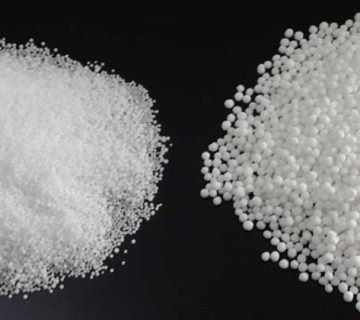
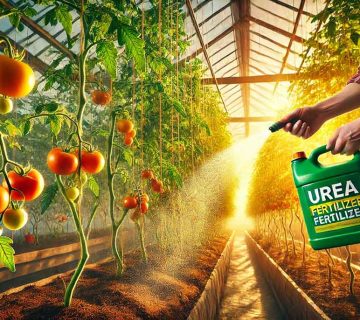
No comment